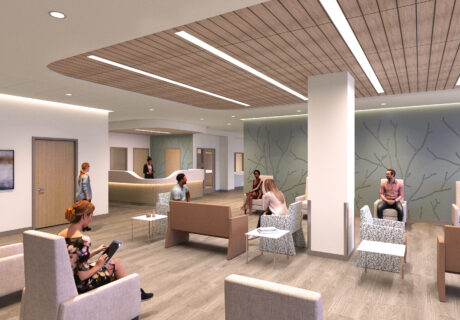When Disaster Strikes: Setting The Standard
This article is part of an expanded online version of “When Disaster Strikes,” a special report on designing for resiliency and disaster preparedness that was first published in the March 2019 issue of Healthcare Design.
In November 2017, the U.S. Green Building Council (USGBC) formally adopted RELi, a resilience consensus standard developed by Perkins+Will and the Institute for Market Transformation to Sustainability (MTS). One year later, Healthcare Design checked in with Doug Pierce, director of Perkins+Will’s Resilience Lab who helped create the RELi standard, as well as Julie Frazier, senior medical planner at Perkins+Will, who’s working on two of the program’s pilot healthcare projects.
Healthcare Design: Fill us in a little on the background for RELi.
Doug Pierce: Work on RELi was inspired by an ever-growing awareness that serious climate change was no longer something that was going to happen in the future; it is happening now. For me personally, a series of extreme rain and flooding events in the upper Midwest between early 2008 and the summer of 2012 signaled that the climate had seriously changed. Then Superstorm Sandy hit on the east coast in fall 2012, and it became clear to a lot of people that is was time to start not only mitigating for future climate change impacts but adapting to the change that was here and on the way in the near-term. MTS led the standards development process, and we collaborated with a range of professionals from different professions, industries, and government between 2012 and 2014 to develop RELi.
In your own words, how do you describe the standard?
Pierce: RELi is a “catalog of actions” for creating a more resilient world that’s better adapted to climate change, supports biodiversity, and is more socially equitable. In the simplest terms, those are the three synergistic areas of resilience that most urgently need to be addressed. We focused most of our efforts at the building and neighborhood scales, because they’re the most immediately actionable place to start. The big idea behind RELi is to move forward from the array of sustainable design work that’s been developed over the past 20 years. We used sustainable design actions and methods that support resilience, and then filled the gaps with a series of pioneering new concepts.
What’s the relationship between resiliency and green building?
Pierce: The green building movement really got its start in the ‘70s as an energy resilience movement, in response to the energy crisis created by the oil embargo. From that perspective, resilience has always been a part of sustainability. Today, along with energy security, resilience is responding to the instability being caused by climate change, biodiversity loss, and social inequity. Many of the actions you might think of as sustainable design actually support resilient design.
For example, a sustainable action like energy efficiency supports resilience by reducing the energy demand of a building. Less energy demand means you can have a smaller back-up power plant or run your stored energy longer if the grid is down. In other words, if you are energy efficient, you need fewer solar panels, fewer batteries, or a smaller generator, plus you are reducing your carbon footprint.
Under USGBC, how does RELi work?
Pierce: RELi is rating system that works a lot like LEED, with certain prerequisites you have to meet and credits you select credits to achieve points. Then you earn a score and receive a rating—Certified, Silver, Gold, or Platinum. At the moment, RELi pilot certifications can be pursued as a companion to a LEED certification, but in the future, RELi will be a standalone certification. RELi will continue to be democratically developed as a consensus standard by USGBC, similar to the development of LEED.
At the time of adoption, there were two RELi pilot projects—Christus Spohn Hospital in Corpus Christi, Texas, and Oklahoma Medical Center in Oklahoma City, Okla. Why were two hospitals among the first to test the standard?
Julie Frazier: Hospitals are a vital part of the community and continuously perform life-sustaining measures. It’s imperative that they remain operational not only for their current patients, but also for the influx of patients that will occur in the face of a future disaster. A standard like RELi goes above and beyond code requirements to encourage building to a more resilient and long-term future.
What’s been learned from those pilot projects?
Julie Frazier: The clients at both pilot projects realized the importance of having more resilient buildings for their project locations. With recent hurricanes hitting the Gulf Coast and tornadoes in Oklahoma, it’s crucial that these facilities remain operational as long as possible. We’ve learned that it’s critical to meet with the client and teams early on to design and plan for a truly integrated and resilient building.
It’s now been over a year since the USGBC adoption. What progress has occurred since then?
Pierce: In the past, only an abbreviated version of RELi was publicly available. As of Jan. 22, the entire RELi standard is publicly available for download (https://www.usgbc.org/resources/reli-20-rating-guidelines-resilient-design-and-construction). Publishing the full standard required a big push by the national RELi Steering Committee. We worked diligently to reconfirm RELi’s pioneering criteria and to synergize the LEED pilot credits with RELi. The process resulted in some administrative clarifications and the reformatting of the RELi guidelines book, but none of the intent or fundamental criteria were changed. Points and weighting were also added so that RELi can be used as a true rating system.
Where does RELi stand today, and where do you see it and resilient building design heading?
Pierce: We plan on using the project feedback we received over the past four years to make RELi even more salient and to better meet client needs. As it becomes clear to more and more people that extreme weather is now a new normal, it will be an imperative that hospitals become truly resilient and stay online during an extended crisis. I think hospitals will become more and more self-reliant, in many ways like they were 100 years ago, but using the latest technology.—Jennifer Kovacs Silvis
To read the full special report, “When Disaster Strikes,” go here.




